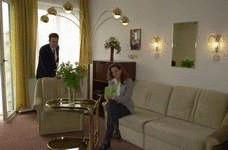|
|
|
|
Several buildings, which once had been attached to
the Civil Hospital, were assembled - further details can't be detected any more.
1771 the second part of the inn, Griesplatz no 7, was built together from two
houses. |
|
|
|
|
|
At that time the biggest and most beautiful ballroom of Graz, the so-called Schwadt'sche Dance Hall, was opened by his then owner Schwadt. The typical 19th century carrier-inn was well surrounded by a beer-garden and a bowling alley. From here the carriage left to Deutschlandsberg.
Among others the inn was a popular hostel for travellers, journeymen, cutlers and blacksmiths. More facts to be looked up in the book "Grazer Gastlichkeit" published by Leykam Verlag.
|
From 1958/59, under the couple Ludmilla and Hermann Lang, modern times came to the decayed walls. By staging large-scale modifications, modernisation and construction work began - following the changes of times, progress and genius of the period. |
|
|
|
|
In 1963 a dancing room was opened again. The
"Laerchen Dance Hall" followed the old tradition and was one of the
most important places for events and meetings on the right side of the river
Mur. |
Since 1976 the house owner's daughter continued the building tradition. Rooted
in hospitality with body and soul, Margit R. Joebstl has run the fortunes of
the house since that time. Following the signs of the time, in 1988 the
gastronomic part was closed and activities focused on accommodation.
|
|
|
The electronic key card has been a novelty in Graz for years, too. A public
short- and long-term car park completes the wide range of ![]() hotel & lodgings.
hotel & lodgings.
P.S.: As a pioneer work of different kind Mrs. Joebstl took the private pilot licence 1973 and became Austria's first female helicopter pilot 1990.




